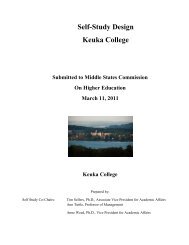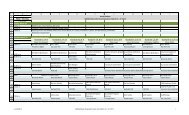final version of the self-study document - Keuka College's Middle ...
final version of the self-study document - Keuka College's Middle ...
final version of the self-study document - Keuka College's Middle ...
Create successful ePaper yourself
Turn your PDF publications into a flip-book with our unique Google optimized e-Paper software.
priorities. In keeping with <strong>Keuka</strong>’s student-centered mission, <strong>the</strong> faculty reward system has<br />
strongly supported teaching but has not supported research or scholarship in equal measure<br />
although scholarship is recognized and valued both in initial hiring and in tenure decisions. With<br />
<strong>the</strong> expansion <strong>of</strong> its graduate programs, <strong>Keuka</strong> finds it<strong>self</strong> looking toward implementing higher<br />
expectations for pr<strong>of</strong>essional and scholarly work. The Vice President for Academic Affairs has<br />
requested that <strong>the</strong> appropriate faculty committees address <strong>the</strong> following areas:<br />
Adoption <strong>of</strong> a college-wide definition <strong>of</strong> scholarship; under consideration is Ernest<br />
Boyer’s seminal work, Scholarship Reconsidered: Priorities <strong>of</strong> <strong>the</strong> Pr<strong>of</strong>essoriate<br />
Revision <strong>of</strong> <strong>the</strong> current reappointment, promotion, and tenure policies to reflect enhanced<br />
scholarship expectations<br />
Preliminary analysis <strong>of</strong> <strong>the</strong> impact <strong>of</strong> enhanced scholarship expectations on advising,<br />
service, and participation in institutional governance<br />
Adoption <strong>of</strong> a policy outlining scholarship expectations for faculty holding graduate<br />
status<br />
Review <strong>of</strong> comparable institutions to identify evidence-based working models for<br />
determination <strong>of</strong> faculty load to support graduate programs<br />
Preliminary budget analysis to determine <strong>the</strong> fiscal implications <strong>of</strong> reductions <strong>of</strong> faculty<br />
load for graduate teaching<br />
Preliminary analysis <strong>of</strong> <strong>the</strong> impact <strong>of</strong> course reductions in terms <strong>of</strong> <strong>the</strong> need for new<br />
faculty positions to <strong>of</strong>fset load reductions<br />
Preliminary analysis <strong>of</strong> <strong>the</strong> resources needed to support increased faculty and student<br />
research activities, including library resources<br />
Preliminary analysis <strong>of</strong> <strong>the</strong> adequacy <strong>of</strong> pr<strong>of</strong>essional development funds (travel,<br />
participation in pr<strong>of</strong>essional associations)<br />
Any modifications to <strong>the</strong> promotion and tenure process will require <strong>the</strong> involvement <strong>of</strong> <strong>the</strong> entire<br />
academic community as well as <strong>the</strong> support <strong>of</strong> institutional leadership in order for <strong>the</strong> college to<br />
implement multiple pathways to tenure.<br />
As indicated above, faculty workload and compensation will be important components <strong>of</strong> this<br />
change process. Whereas <strong>the</strong> faculty benefitted from a 35% increase in faculty salaries over a<br />
five-year parity plan which was concluded in 2008 with an additional 2% in 2010-2011, 3.5% in<br />
2011-2012, and budgeted for 3.5% in 2012-2013, a new compensation plan has yet to be<br />
developed; <strong>the</strong> College leadership anticipates this new compensation plan will be within <strong>the</strong><br />
context <strong>of</strong> <strong>the</strong> long-range strategic planning process. Two new elements <strong>of</strong> this dialogue are <strong>the</strong><br />
Carnegie reclassification <strong>of</strong> <strong>Keuka</strong> as a Master’s College (Smaller Programs) and <strong>the</strong><br />
development <strong>of</strong> a new peer list by <strong>the</strong> collaborative efforts <strong>of</strong> <strong>the</strong> administration, faculty, and<br />
staff which was <strong>final</strong>ized in February 2012. Additionally, we have identified <strong>the</strong> need for<br />
determining a process or mechanism for ensuring greater equity in workloads, taking into<br />
account <strong>the</strong> service role <strong>of</strong> division chairs, committee chairs, assessment coordinators, and <strong>the</strong><br />
differences between <strong>the</strong> traditional and ASAP models. For instance, points <strong>of</strong> difference between<br />
faculty teaching in <strong>the</strong> ASAP model and faculty teaching in <strong>the</strong> traditional program are number<br />
<strong>of</strong> contact hours, average number <strong>of</strong> students per calendar year, number <strong>of</strong> courses assigned,<br />
average number <strong>of</strong> advisees, travel expectations, 12-month versus 10-month contracts, and<br />
expectations for service. With regard to <strong>the</strong> latter, as was noted in a Pr<strong>of</strong>essional Standards<br />
Page 13 <strong>of</strong> 39 Chapter 6: Faculty, Ed Offerings & GenEd




